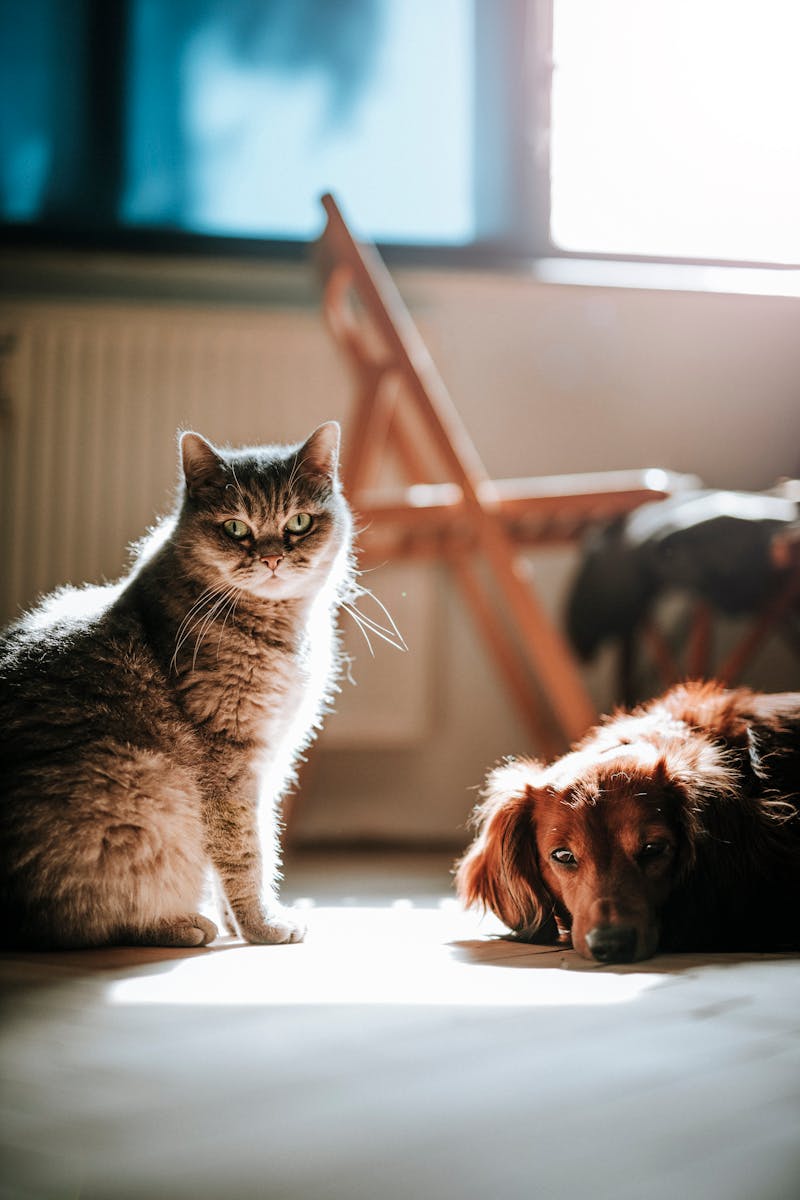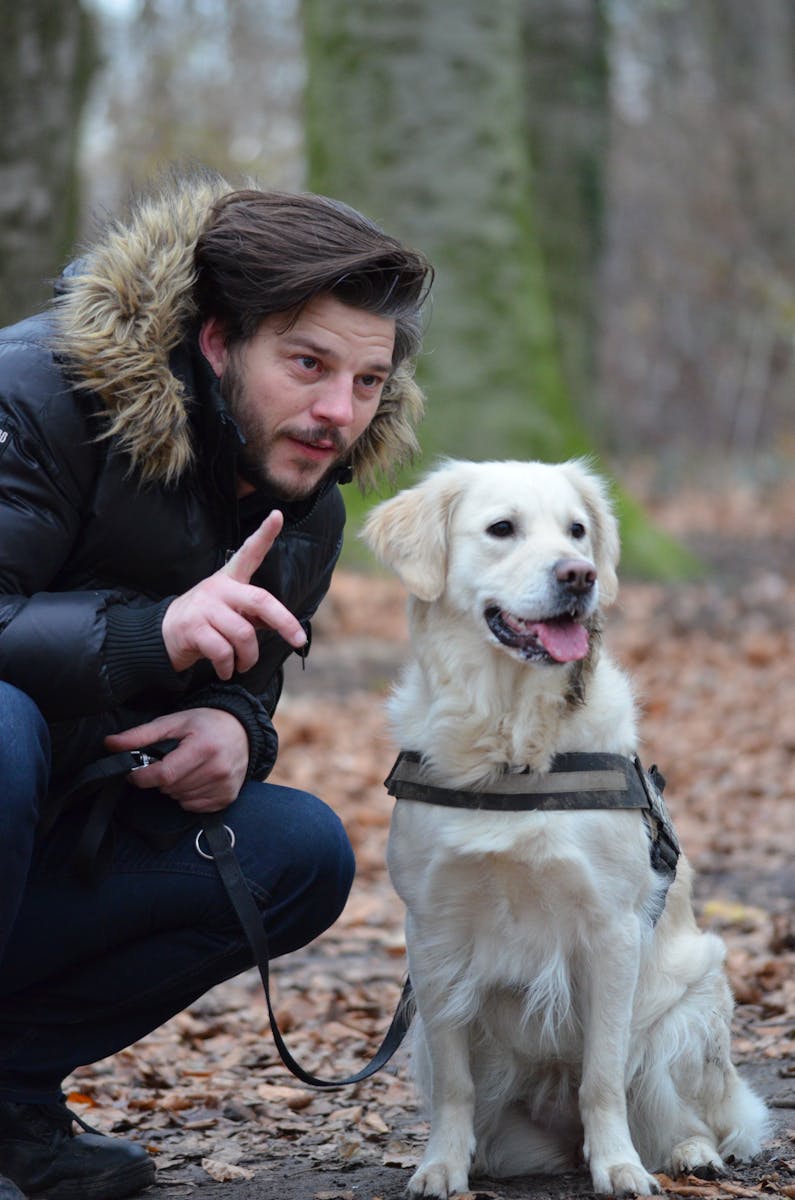Integrating Multi-Pet Households: Behavioral Strategies for Harmony
Understanding Multi-Pet Dynamics: The Importance of Unique Personalities and Social Structures
Bringing multiple pets into your home can be a joyful and fulfilling experience. However, understanding the unique personalities and social structures within a multi-pet household is crucial for creating a harmonious environment. Whether you have a blend of dogs, cats, birds, or even reptiles, each animal has its own set of behaviors and social interactions that can greatly influence life under one roof. Let’s dive into the complexities of multi-pet dynamics and how you can ensure a peaceful coexistence among your furry—and not-so-furry—friends.
The Essence of Multi-Pet Dynamics
The Unique Personalities of Pets
Every pet has its distinct personality, which can be shaped by breed, early socialization, individual experiences, and even species. Here are some common personality types you might encounter in your multi-pet household:
- The Leader: Often characterized by confidence and assertiveness, this pet tends to take charge. Usually belonging to more dominant breeds or species, these pets will often set the tone for the interactions within the household.
- The Follower: This type is typically more passive and may look to the leader for guidance. They might feel more secure when other pets are around, creating a social dynamic where they rely on the assertiveness of others.
- The Social Butterfly: Some pets thrive on social interactions, actively seeking out play and companionship. They often help bridge gaps between different species or more introverted pets.
- The Loner: Some pets prefer solitude and may shy away from interaction with others. They require more understanding and space to thrive in a multi-pet setting.
Inter-Species Interactions
When different species live together, their interactions can be fascinating and complex. For example, cats and dogs are common combinations in many households, yet their social structures vary significantly:
- Cats: Cats are generally solitary creatures. They might tolerate or even enjoy the presence of other species, but often on their own terms. A cat’s body language is essential to observe; a slow blink can signify comfort, while an arched back indicates stress.
- Dogs: Dogs are pack animals and thrive on social connections, not only with their human companions but also among other pets. The type of dog breed can also influence how they interact with other animals. For example, a herding breed may instinctively try to round up other animals, while a more laid-back breed might cohabitate peaceably.
By understanding these differences, pet owners can better manage interactions and prevent conflicts, leading to a smoother coexistence.
Establishing a Positive Social Structure
Gradual Introductions
The success of a multi-pet household often starts with the way pets are introduced to each other. Gradual introductions allow pets to acclimate to one another, reducing stress and aggression. Here are some tips for effective introductions:
- Separate Spaces: Begin by allowing pets to have their own spaces with their favorite toys and beds. This helps them feel secure in their territory.
- Scent Swaps: Before direct interaction, swap bedding or toys between the pets, so they get used to each other’s scents without direct contact.
- Controlled Meetings: Use a leash or a pet gate for initial introductions. This allows you to control the situation and gauge how both pets react to each other.
- Short Duration: Keep the first meetings brief and positive. Gradually increase the time they spend together as they demonstrate comfort with each other.
Socialization Experiences
Ensuring that each pet receives ample socialization can dramatically improve the overall dynamic. Regular outings, playdates, and even organized training sessions can help pets learn to communicate and interact with others appropriately.
For example, taking your dog to puppy school not only reduces their anxiety around other dogs but also teaches them how to read canine body language—skills which they can then pass on to their feline housemates by example!
Space and Resources
To prevent resource guarding and territorial disputes, it’s essential to provide separate spaces and resources for each pet. Here’s how you can manage this effectively:
- Feeding Stations: Set up separate feeding areas to avoid competition, as food can be a significant source of tension.
- Play Zones: Provide diversified play areas with different types of toys. Cats may appreciate vertical spaces like cat trees, while dogs will enjoy roaming around in a fenced yard.
- Private Retreats: Create cozy corners or hideaways where a pet can retreat when feeling stressed or overwhelmed.
Analyzing Behavior for Improved Harmony
The key to understanding multi-pet dynamics is observing behavior and responding fairly. Here are a few signs to look out for:
- Body Language: Pay close attention to your pets’ body language as this is often the first indicator of discomfort or aggression. Ears back, hissing, or avoidance in cats, or barking and raised hackles in dogs should be noted and addressed.
- Vocalizations: Different species vocalize differently. Cats may hiss or growl, while dogs might bark or whine. Understanding what these sounds mean can help in interpreting their feelings and reactions.
- Posture Changes: If one pet is displaying submissive postures, such as rolling over or crouching, others may read this as an invitation to assert dominance. Be ready to intervene if necessary.
Conclusion: Create Your Ideal Multi-Pet Household
Understanding the unique personalities and social structures of each pet can go a long way in creating a harmonious multi-pet household. By introducing pets gradually, ensuring they have their own spaces, providing socialization experiences, and closely monitoring their interactions, you will be well on your way to fostering a peaceful environment for all.
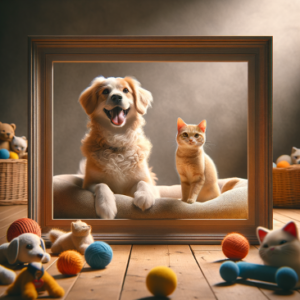
Establishing Stable Hierarchy: The Necessity of Clear Hierarchies Among Pets
In a multi-pet household, establishing a clear hierarchy can drastically reduce conflicts and foster a more peaceful living environment. Just as society operates within structured dynamics, so does the animal kingdom, where each pet has its defined role. Recognizing and reinforcing these roles can lead to less stress for both pets and owners and create a more enjoyable atmosphere for everyone involved.
Why Hierarchy Matters in Multi-Pet Households
Hierarchy serves several crucial functions in the relationships between pets. Understanding these dynamics can help prevent conflicts:
- Minimizes Aggression: By defining roles, pets are less likely to compete for resources or attention. When pets understand their position within the hierarchy, they’re less likely to challenge one another.
- Promotes Confidence: A clear social structure provides reassurance to pets, especially those who are naturally more anxious or submissive. Knowing who leads allows them to feel secure within their environment.
- Facilitates Better Communication: Communication between pets improves when there is an established hierarchy. Language, both verbal and body, often aligns with their role, leading to fewer misunderstandings.
Methods to Identify Hierarchy
Identifying your pets’ social structure begins with careful observation and understanding of their behaviors. Here are some strategies:
- Observe Interactions: Watch how your pets engage with one another during playtime or meal periods. The pet that takes the initiative in these situations is often the leader.
- Feed Dynamics: Feeding time can reveal a lot about hierarchy. Notice who eats first, who monitors who eats, and how pets behave in the presence of food. The most dominant pet often claims the best spots or resources.
- Body Language Indicators: Dominant animals may stand tall, hold their tails high, and have direct eye contact with other pets, while submissive animals may lower their heads, avoid eye contact, and tuck their tails. Observing these behaviors can help you discern the social standing.
- Play Behavior: Watch for who leads play sessions and who follows. A pet that frequently instigates play and manages the dynamics is likely in a higher rank.
Methods to Maintain a Healthy Hierarchy
Once you have identified the hierarchy in your pet household, maintaining it is key to harmony. Here are some actionable tips:
- Consistent Reinforcement: Always reward positive behaviors that align with the hierarchy. If a pet is displaying respectful behavior towards a higher-ranking pet, praise or treat them to encourage that good behavior.
- Controlled Interactions: When introducing new pets or altering the household dynamic, manage interactions. Use leashes or crates during initial introductions to prevent territorial disputes and ensure that the established pecking order isn’t disrupted.
- Monitor Behavior: Always keep an eye on interactions, especially during potential conflict situations like feeding or playtime. If you notice a higher-ranking pet being overly aggressive or a lower-ranking pet becoming distressed, intervene calmly but firmly to redirect behavior.
- Training Sessions: Teaching commands can reinforce hierarchy. Obedience training builds respect and communication skills. Engaging in training activities can help illustrate the roles pets hold, especially when reinforcing commands that require following the lead of the pet that is more dominant.
Understanding Changes Over Time
It’s essential to recognize that social structures can evolve as pets grow, especially when introducing new members to the household or when existing pets reach different stages in life:
- Changes in Age: Younger pets may challenge the established hierarchy, especially if they’re more active or sprightly. Observe how the older pets respond to maintain necessary boundaries.
- Health Issues: A formerly dominant pet dealing with health concerns may either lose or struggle to maintain their rank. Watch for behavioral changes that signify their new dynamic.
Real-World Example: The Balanced Act of a Dog and Cat Household
Consider a household with an older dog and a younger cat. The older dog, with established dominance and calm demeanor, tends to initiate social play but becomes wary of aggression when the young cat pounces unexpectedly. The owner ensures mealtime is orderly by feeding the dog first while keeping the cat distracted with a puzzle toy.
The dog remains relaxed and confident as the cat grows accustomed to waiting for her turn. Additionally, during play, the owner maintains a structured playtime where both pets receive turns and praise while allowing the older pet to have its lead in games, helping reinforce the established hierarchy.
Conclusion: The Importance of a Stable Hierarchy
By recognizing, establishing, and maintaining a stable hierarchy among your pets, you unlock the potential for a more peaceful and fulfilling multi-pet household. Awareness of your pets’ unique personalities and their social standings not only contributes to harmony but also enriches the overall bond you share with your furry family.

Socialization Techniques: Strategies for Proper Socialization of Pets
Socialization is a critical component of your pets’ well-being, especially in a multi-pet household. Proper socialization techniques not only help pets feel comfortable around one another but also cultivate positive behaviors that enhance their interactions. In this section, we will explore effective strategies for socializing your pets, discussing introductions, playtime routines, and the pivotal role of positive reinforcement during social interactions.
Gradual Introductions to Foster Trust
First Impressions Matter
The initial meeting between pets can set the tone for their future interactions. Therefore, managing introductions carefully is vital. Here are essential steps to ensure pets feel safe and supported:
- Start with Sight: Begin by allowing pets to see each other from a distance. This can involve keeping them in separate rooms with a baby gate or using leashes for dogs. This way, they can observe each other without direct contact.
- Time to Sniff: After a few controlled meetings, let your pets get close while on a leash. Allow them to sniff each other—this is a natural way for animals to gather information and establish comfort.
- Short Sessions: Keep initial interactions short to prevent overwhelming either pet. Gradually increase the duration of these meetings as they show signs of comfort.
Encourage Positive Interactions
Reinforcing good behavior during these early meetings can pave the way for lasting friendships. This involves rewarding your pets when they exhibit calm and friendly behaviors around one another. A few effective strategies include:
- Verbal Praise: Use a soft, soothing voice to commend your pet when it approaches the other pet calmly.
- Treat Rewards: Offer yummy treats when either pet demonstrates positive behavior, such as relaxing or playing together.
- Playtime Duo: Equip yourself with engaging toys suited for both pets during playtime. This can be particularly useful for dogs who may need higher energy activities and cats who enjoy interactive play.
Creating Playtime Routines
Playtime: The Language of Pets
Playtime can be an excellent opportunity for pets to build bonds and learn social cues. Here’s how to structure play sessions effectively:
- Set the Scene: Designate specific times for play that are consistent throughout the week. Regular playtimes will help both pets adapt to a routine and minimize anxiety.
- Interactive Toys: Choose toys that promote interaction. For example, a flirt pole can engage both cats and dogs while encouraging chase and play, enhancing their connection.
- Mix Up Activities: Introduce various games to keep things interesting. Play fetch with dogs while allowing the cat to engage through a toy on a string or a laser pointer. This way, both pets can play together in a controlled environment.
Supervised Fun
Keep a close eye on their interactions during playtime. Look for signs of stress or discomfort, like growling or hissing from cats or excessive barking from dogs. If you notice any negative behavior:
- Intervene Calmly: Distract your pets with a noise or toy to shift focus.
- Take Breaks: Allow pets to have short breaks during play to rest and process their interactions.
The Role of Positive Reinforcement
Building Confidence Through Reward
Positive reinforcement is essential in helping pets form healthy sociability and reduce anxiety. Here’s how to implement it effectively in social interactions:
- Reward Good Behavior: Whenever pets show interest in each other or play nicely, reward them with treats or praise. This helps them associate positive experiences with the presence of other pets.
- Recognize Boundaries: Acknowledge when a pet needs a break. If one pet walks away or indicates they need space, don’t force interaction. Allow them that time to cool off, and reward them later when they re-engage positively.
- Consistency is Key: Make sure to consistently reinforce positive behaviors in all interactions. This involves patience and persistence, as building relationships takes time.
Analyze Progress
Regularly assess how your pets are adjusting. Keep a journal to note their interactions, responses to each other, and any changes in behavior over time. Measuring progress helps you identify what works best and where adjustments may be needed.
Conclusion: Nurture Positive Socialization Strategies
Utilizing these socialization techniques—careful introductions, structured playtime routines, and consistent positive reinforcement—creates a foundation for harmonious interactions among pets. By committing to these strategies, you will foster a loving and peaceful atmosphere in your multi-pet household.
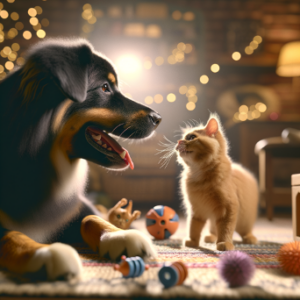
Creating Separate Spaces: Crafting Personal Retreats for Your Pets
Establishing individual spaces for each pet is paramount in a multi-pet household for reducing stress, promoting well-being, and ensuring peaceful coexistence. By recognizing that pets thrive in environments tailored to their preferences and temperaments, you can minimize conflicts and create a sanctuary for every furry (or scaly) companion. Here, we’ll explore actionable tips on how to effectively set up these personal spaces.
The Importance of Designated Personal Spaces
Why Personal Spaces Matter
Having a designated personal space is crucial for pets as it allows them to retreat when they feel overwhelmed or stressed. Here are some benefits that these unique spaces provide:
- Reduces Stress: Pets can escape to their safe zones when faced with overwhelming stimuli or tension from other pets.
- Promotes Security: A personal space filled with familiar scents and belongings helps pets feel secure and relaxed.
- Encourages Independence: Pets can choose when to interact or withdraw, thus fostering a sense of autonomy.
- Diminishes Territorial Disputes: When pets have their own spaces, there’s less likelihood of competition or territorial disputes over common areas.
Key Elements for Setting Up Personal Spaces
Creating welcoming personal spaces requires thoughtful planning. Here’s how you can set up these essential retreats:
- Select the Right Location: Choose quiet corners of your home that are free from heavy foot traffic. This could be a cozy nook in the living room, a corner in your bedroom, or a dedicated space in a less frequented area of the house.
- Use Appropriate Bedding: Provide comfortable bedding or a designated bed that fits their size and comfort preferences. Soft, plush surfaces can help create a warm and inviting environment.
- Incorporate Favorite Toys: Filling their space with toys helps your pet associate their retreat as a fun place. Include a variety of toys—chewy, interactive, and soft—for dogs, and engage would-be climbers with scratching posts or balls for cats.
- Keep It Clean and Safe: Ensure that these spaces are safe and clean, free from hazards or harmful items. Regular cleaning helps maintain a pleasant environment and fits your pet’s health and wellbeing.
- Shade and Coziness: Create a sense of coziness by including shade or covers in their spaces. A pet tent, blanket fort, or even a simple cardboard box can attract your pet’s curiosity and satisfaction.
Personalizing Spaces According to Individual Needs
Every pet is unique, and their personal spaces should reflect their individual needs and preferences. Here are specific tips tailored for different types of pets:
- Dogs: For canines, a crate can serve as a personal retreat that mimics a den. Make it comfortable with cushions and familiar items. Be sure to place it in a quiet spot, allowing them to keep an eye (or ear) out for you if they want.
- Cats: Cats are known for seeking out high spots. Creating vertical space, like shelves or cat trees, can provide both security and a good lookout point. Include soft bedding in their elevated hangout or cozy boxes where they can hide away.
- Small Pets: For rabbits, guinea pigs, or ferrets, separate areas in the living space should include tunnels, hideouts, and lots of bedding material. This freedom to explore encourages natural behavior while providing a safe haven.
- Reptiles: Ensure reptiles have hiding spots and areas that mimic their natural habitats. Set up spaces with appropriate temperatures and humidity, ensuring your scaly friends can retreat if they feel stressed.
Monitoring and Adapting Spaces
Once you’ve set up personal spaces, it’s important to regularly monitor how well your pets are using them. Here are some tips to evaluate and adapt accordingly:
- Observe Behavior: Is your pet using their space? Are they spending more time there during stressful situations? Use their behavior as an indicator of how well the space meets their needs.
- Make Adjustments: If a pet seems reluctant to use their designated area, consider modifying elements such as bedding, location, or toys. Pets undergo changes in preferences, much like humans, and adapting can rejuvenate their interest.
- Create a Routine: Encourage your pets to use their personal spaces regularly by creating positive associations. You might reward your pets with treats or playtime when they choose to go to their space.
- Consider Additional Spaces: If conflicts arise, or if you see more aggressive behavior, it may be beneficial to provide additional areas for your pets. Having multiple options can alleviate tensions and cater to varying personalities.
Conclusion: Fostering Peace Among Pets Through Separate Spaces
Fostering a harmonious multi-pet household involves recognizing the need for personal spaces, allowing each pet to find comfort, safety, and independence. Properly designed areas enhance your pets’ overall well-being while minimizing stress and territorial disputes. By following these actionable tips, you can help create a loving and peaceful living environment for each of your cherished companions.
What do you think about setting up separate spaces for pets? Have you had success with this approach? We’d love to hear your stories and tips in the comments! If this article resonated with you, please share it to help other pet owners create their ideal living spaces.

Feeding Strategies: Influencing Competition and Aggression Among Pets
In a multi-pet household, the feeding strategy you implement can significantly influence the dynamics between your pets. The way in which food is presented, the timing of meals, and even the type of feeding method can either foster a sense of community or spark competition and aggression. By understanding how feeding schedules and methods can impact your pets’ interactions, you can promote harmony in your home. Let’s explore effective feeding practices that can minimize conflicts and encourage a peaceful environment.
Crafting an Effective Feeding Schedule
Consistency is Key
Establishing a consistent feeding schedule can help pets anticipate mealtimes and reduce anxiety. Here are some pointers to create an effective routine:
- Same Time, Every Day: Feed your pets at the same time each day. This creates predictability and can ease any anxiety that might arise around feeding times.
- Monitor Individual Needs: Some pets may require multiple small meals per day, while others might thrive on one or two larger meals. Tailor your schedule to meet the specific needs of each pet.
- Use a Timer or Alarm: If you are often away during feeding hours, consider using an automatic feeder. This not only ensures timely meals but also prevents one pet from monopolizing food resources.
Meal Separation Techniques
To avoid competition and aggression during mealtimes, implementing separation techniques can play a vital role. Here are some effective methods:
- Feeding in Different Rooms: If possible, feed pets in separate rooms. This limits the chances of one pet intruding on another’s meal, reducing anxiety and potential aggression.
- Visual Barriers: If separate rooms are not an option, consider using baby gates or screens to create visual barriers. This maintains proximity without allowing physical interactions during meals.
- Individual Feeding Stations: Set up distinct feeding areas tailored to your pets’ needs. For cats, elevated feeding stations can provide security, while dogs may benefit from meals placed on elevated surfaces to prevent resource guarding.
Utilizing Appropriate Feeding Methods
Slow Feeders and Puzzle Bowls
Feeding methods can also influence competition. Utilizing slow feeders or puzzle bowls can provide enrichment and discourage hurried eating, which may lead to aggression.
- Slow Feeders: These bowls are designed to slow down consumption, allowing pets to focus on their food and reducing the likelihood of disputes. By making pets work for their food, you can prolong their eating time, fostering a calmer mealtime atmosphere.
- Puzzle Feeders: These interactive feeders encourage pets to engage with their food, enhancing their mental stimulation. The added challenge can also shift their focus away from potential competitors in the household.
Incorporating Treats and Rewards
Using treats strategically can reinforce positive behavior around mealtime. Here are some suggestions:
- Timing Treats with Feeding: When introducing new pets or during mealtime, reward calm behavior with treats. This helps pets associate good behavior with positive outcomes, fostering a more peaceful feeding environment.
- Using Treat Dispensing Toys: Introduce toys that dispense treats during feeding times. This provides mental stimulation and can redirect focus away from competition for food.
Real-World Examples of Successful Feeding Strategies
Consider the case of Sarah, a cat and dog owner who faced challenges with aggressive feeding behavior. After observing her pets competing for food, she transitioned to a structured feeding routine. By feeding them in separate rooms at the same time each day and utilizing slow feeders, she noticed a significant reduction in hostility. In fact, her dog began to approach mealtime with a calmer demeanor, while her cat felt secure in her feeding zone, enhancing their overall relationship.
Another example involves a multi-species household with two dogs and a cat. The owner set up elevated feeding stations for the cat and designated feeding areas for each dog to prevent resource guarding. By allowing each pet their own space, tensions decreased remarkably, fostering a cooperative and peaceful feeding atmosphere.
Conclusion: Creating Harmony Through Strategic Feeding
The effects of feeding schedules and methods on intra-pet competition and aggression cannot be understated. Establishing consistent feeding routines, implementing separation techniques, and utilizing appropriate feeding methods are essential strategies for promoting harmony in a multi-pet household.

Handling Resource Guarding: Strategies for a Harmonious Multi-Pet Environment
Resource guarding is a common behavior in pets that can lead to conflict in a multi-pet household. This defense mechanism, where a pet reacts protectively over food, toys, or even their human caregiver, can create tension amongst otherwise friendly companions. Understanding and managing resource guarding is essential to foster a peaceful environment. Let’s explore strategies to address resource guarding and techniques for desensitization and positive reinforcement.
The Nature of Resource Guarding
Understanding Resource Guarding Behavior
Resource guarding can manifest in various ways, including growling, snapping, or even a stiff posture. A pet may feel threatened by a perceived competition for resources and, as a result, display aggressive behavior. Common triggers include:
- Food: Many pets guard their food dishes, especially during meals, as this is a fundamental resource for survival.
- Toys: Pets may become possessive of toys, particularly those they find particularly stimulating or enjoyable.
- Attention: Some pets may display guarding behaviors when they feel another animal is encroaching on their bond with their human companions.
Recognizing the signs of resource guarding is the first step toward effective management.
Prevention Strategies
Prevention plays a key role in addressing resource guarding before it escalates. Here are some actionable tips:
- Teach “Leave It” and “Drop It”: Training your pets on commands like “leave it” and “drop it” can help manage their reactions to perceived threats. Begin by rewarding them when they willingly relinquish a toy or food item.
- Manage Feeding Dynamics: Feed your pets in separate areas to reduce competition. This prevents situations where one pet may feel compelled to guard its food against another.
- Rotate Toys: Instead of giving all toys at once, rotate them on a schedule. This keeps the excitement level high while reducing the likelihood of guarding behavior over a single toy.
- Controlled Introductions: When introducing new resources, especially toys or treats, do so in a controlled manner. Use leashes or barriers to create a safe distance between pets, allowing time for adjustment.
Desensitization Techniques
Gradual Exposure and Positive Reinforcement
Desensitization is a key technique in managing resource guarding. The goal is to help your pet associate previously guarded resources with positive experiences. Here’s how to implement this method effectively:
- Proximity Training: Start at a distance where the guarding pet feels comfortable around a resource. Gradually decrease the distance over time as they become more relaxed. Use treats, praise, or gentle petting as rewards during this process.
- Controlled Scenarios: Create situations where the pet can safely encounter another pet with a shared resource. For example, have one pet eat while the other is nearby but on a leash. Gradually allow the leashed pet to approach closer, rewarding calm behavior.
- Resource Sharing: Encourage sharing by introducing high-value treats while both pets are present. This can help shift their focus from guarding to enjoying the resource collaboratively.
- Positive Reinforcement: Always reward non-aggressive behavior with treats and affection. This reinforces the idea that good things happen when there is a presence of other pets around resources.
Behavior Modification Techniques
In some cases, modifying the pets’ reactions to resources will be necessary. Here are a few techniques to integrate into your ongoing training:
- Behavior Replacement: If a pet demonstrates guarding behavior, redirect their focus to a behavior that is more acceptable, such as sitting quietly or engaging in a different activity.
- Management Tools: Consider using tools like basket muzzles during feeding or playtime to prevent aggressive behavior while allowing for safe interactions. Just ensure to introduce the muzzle positively to avoid any negative associations.
- Professional Guidance: If resource guarding persists or escalates, working with a professional animal behaviorist can provide you with tailored strategies. They can help assess the situation and offer specialized training techniques.
Conclusion: Promote Peace and Understanding
Addressing resource guarding among pets is crucial for establishing a harmonious multi-pet environment. By understanding the triggers and employing effective desensitization and positive reinforcement techniques, pet owners can nurture peaceful coexistence. The key takeaways include recognizing resource guarding signs, managing feeding dynamics, and incorporating desensitization strategies through gradual exposure.
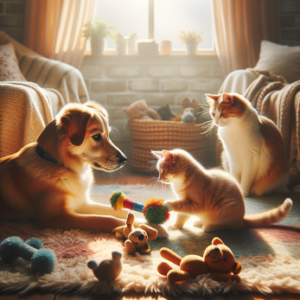
Training for Cooperation: Recommended Exercises for a Harmonious Multi-Pet Household
Creating a peaceful multi-pet household hinges not just on understanding their unique personalities but also on promoting cooperation among your furry friends. Training exercises focused on cooperation can foster better interactions and compatibility among pets, ultimately benefiting the entire household. Here’s a closer look at some effective training exercises that encourage teamwork and collective bonding.
The Importance of Shared Tasks
Engaging your pets in shared tasks can significantly enhance their ability to work together. Here are some ideas for activities that promote cooperation:
1. Group Obedience Training
Group obedience training sessions not only teach essential commands but also help different pets learn to respect one another’s space and cues. By using commands such as “sit,” “stay,” or “down” in conjunction with multiple pets, they will start to understand the importance of working together.
- Actionable Tip: For effective group training, ensure that you have a calm environment free from distractions. Start with a few sessions where pets are kept on leashes and work them in tandem, rewarding them for successfully completing commands as a team.
2. Shared Toy Play
Incorporating toys into playtime can be a delightful way to enhance interaction and cooperation. Use larger toys that multiple pets can engage with, such as tug ropes or interactive puzzles designed for multiple participants.
- Actionable Tip: If your cats and dogs play together, consider toys that can be pulled or shared, like a feather wand or a ball that rolls unpredictably. This encourages each pet to work together to achieve a common goal – catching or retrieving the toy.
3. Obstacle Courses
Setting up a small obstacle course can stimulate mental and physical coordination. Create simple challenges that require pets to navigate through tunnels, weave between cones, or jump over small hurdles. By working together, pets learn teamwork and communication to overcome the course.
- Actionable Tip: Use treats as motivation. When one pet successfully completes a section of the course, reward them. Encourage their cohorts to cheer them on (or even join in)!
4. Training with Targets
Target training involves teaching pets to touch or follow a specific object, which can be a fun way to create cooperation between different species. This method can be adapted to both cats and dogs, and even other pets like birds or rabbits.
- Actionable Tip: Use a target stick or your hand as a target. If one pet successfully reaches the target, reward them, and call another pet to follow. Gradually increase the distance and complexity, ensuring they work together.
5. Feeding Together
To build a sense of community, you can create a routine around feeding time where each pet participates in shared activities before they feast. This can involve a simple training session where they must follow commands or complete small tasks to earn their meal.
- Actionable Tip: Set a designated feeding time. Give each pet a command they must complete (like “sit” or “paw”) before receiving their food. Not only does this build cooperation, but it also enhances their obedience training.
The Benefits of Group Training
Engaging in cooperative training activities provides myriad benefits for the entire household:
- Improved Relationships: Sharing activities fosters bonds among pets, leading to more peaceful coexistence and reduced territorial disputes.
- Enhanced Communication: Group training encourages pets to read one another’s body language and social cues, promoting better understanding among different species.
- Increased Confidence: As pets learn to succeed in cooperative tasks, their confidence grows, making them more adaptable and less likely to exhibit anxiety or aggression.
- Higher Energy Levels: Incorporating physical activities can positively impact your pets’ health, keeping them fit and mentally stimulated.
- Family Cohesion: Households benefit when pets are not just getting along but actively working together. This harmonious dynamic can enhance the emotional welfare of both pets and owners.
Final Thoughts
Training for cooperation among your pets is essential to developing a harmonious and fulfilling multi-pet household. Shared tasks such as obedience training, toy play, obstacle courses, targeting, and even cooperative feeding can cultivate valuable interactions. As you implement these exercises, you’ll foster not only cooperation but also strengthen the emotional connections between your pets, leading to a more tranquil and enjoyable living environment for everyone.

Recognizing Signs of Stress: How Pets Communicate Their Discomfort in a Multi-Pet Environment
Understanding and managing stress in pets within a multi-pet environment is crucial for promoting harmony and well-being. Just as people express their feelings through various behaviors, pets also communicate their stress through specific signs. Awareness and timely intervention can significantly improve your pets’ quality of life and foster a peaceful household. Let’s explore the signs that indicate stress in pets and discuss how to monitor and address these behaviors effectively.
Signs of Stress in Pets
1. Changes in Body Language
Body language is one of the most telling indicators of a pet’s emotional state. Here are common signs to watch for:
- Cats:
- Ears Back: This can indicate fear or irritation. When a cat flattens its ears against its head, it’s a sign they feel threatened.
- Hiding: Cats may seek secluded areas to escape perceived threats. If your normally social cat starts to hide more often, it might be feeling stressed.
- Tail Position: A puffed-up tail can signify a cat is scared, while a low-hanging tail often indicates submission or discomfort.
- Dogs:
- Whale Eye: When a dog turns its head away but keeps its eyes on the other animal, you might see the whites of its eyes—this is an anxiety indicator.
- Excessive Yawning: Just like humans, dogs may yawn when stressed. If you notice your dog yawning frequently in the company of other pets, be wary.
- Tail Tucking: A dog that tucks its tail between its legs signals fear or submission.
2. Changes in Vocalization
Vocalizations can vary widely among pets. Increased or unusual vocalizations can indicate stress.
- Cats:
- Loud hissing or growling can imply that a cat feels threatened or is trying to assert dominance.
- Dogs:
- Excessive barking, whining, or howling can be signs of anxiety or frustration, especially when another pet is nearby.
3. Behavioral Changes
Changes in a pet’s behavior can be significant red flags. Here are some behaviors to look for:
- Increased Aggression or Fearful Behaviors: If a pet that is generally friendly suddenly shows signs of aggression—such as growling, snapping, or acting skittish—it may be feeling overwhelmed.
- Destructive Behavior: Stress can sometimes manifest as destructive behavior, such as chewing furniture, digging, or scratching at doors to escape.
- Changes in Appetite or Grooming Habits:
- Loss of Appetite: A stressed pet may refuse food. Pay attention to feeding habits, as this could indicate distress.
- Over-Grooming: Excessive grooming can be a coping mechanism, leading to skin problems, especially in cats.
Monitoring and Addressing Stress Behaviors
1. Observation and Documentation
Keeping a close eye on your pets’ behaviors and noting any changes is the first step in managing stress. Here are tips to help you monitor their behaviors effectively:
- Routine Checks: Regularly observe your pets during different interactions—especially when introducing new pets or changes within the household.
- Behavior Log: Consider keeping a log of any unusual behaviors, noting the time, circumstances, and the response of other pets. This can help identify patterns or triggers of stress.
2. Providing Safe Spaces
Creating a stress-free environment is vital for your pets’ mental and emotional well-being. Here’s how to ensure they have safe retreats:
- Quiet Retreats: Designate areas where pets can retreat when they need solitude, such as cozy beds or hideaways away from the hustle and bustle.
- Vertical Spaces for Cats: Cats often feel safer when they have elevated perches where they can observe their surroundings without being threatened.
3. Positive Reinforcement and Training
Behavior modification can work wonders in alleviating stress in multi-pet settings. Here are some actionable tips:
- Use Treats and Praise: Reinforce calm behavior with treats and praise during moments of tension. For instance, if pets seem relaxed during supervised interactions, reward them to encourage that behavior.
- Training Sessions: Utilize training sessions to emphasize obedience and communication between pets. This can help establish boundaries and reduce anxiety.
4. Professional Help
If signs of stress persist despite your best efforts, seeking professional advice may be beneficial.
- Veterinarian Consultation: Persistent stress signs can lead to health issues, so it’s essential to rule out any underlying medical conditions.
- Pets Behaviorist: A certified animal behaviorist can provide insights and tailored strategies to address complex interactions and relieve stress within the household.
Conclusion: Fostering a Stress-Free Environment for Your Pets
Recognizing signs of stress in a multi-pet environment is essential for maintaining harmony in your household. By keeping a close watch on body language, vocalization, and behavioral changes, you can effectively monitor your pets’ emotional well-being. Addressing stress promptly—through safe spaces, positive reinforcement, and professional help—can lead to a happier, healthier multi-pet household.
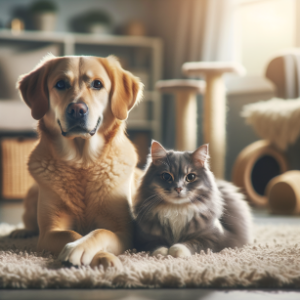
Quiet Time: The Importance of Providing ‘Quiet Time’ for Pets to Decompress
In a bustling multi-pet environment, it’s essential to recognize that just as our human family members need downtime to recharge, our pets do too. Pets can experience stress from various sources—be it the excitement of playtime, conflicts with others, or simply the constant stimulation of a busy household. Providing designated quiet time for pets isn’t just beneficial; it’s crucial for their mental and emotional well-being. Understanding how to implement this necessity can lead to a more tranquil and balanced home.
The Benefits of Quiet Time
Quiet time entails allowing pets moments of solitude and peace. The benefits of incorporating regular quiet time for your pets include:
- Reduced Stress: Pets can become overwhelmed in a busy environment. By creating a quiet space, you give them the opportunity to escape from the stimuli that may cause anxiety.
- Better Relationships: Allowing pets to decompress helps reduce conflicts. Like humans, pets can become irritable when overstimulated, leading to skirmishes or unwanted behaviors. Quiet time promotes harmony.
- Improved Behavior: Regular quiet time can lead to better-adjusted pets. When pets feel safe and relaxed, they are less likely to exhibit behavioral issues such as excessive barking, scratching, or hiding.
- Enhanced Bonding: Providing serene moments where pets can enjoy their own company strengthens their independence, allowing them to appreciate interactions with family members during active periods.
Setting Up Quiet Time Spaces
To effectively implement quiet time, consider creating designated areas throughout your home where pets can retreat and relax. Here’s how to set up these essential spaces:
- Identify Pet Preferences: Observe where each of your pets feels most comfortable. Dogs might prefer a cozy corner of the living room or their own dog bed, while cats often enjoy elevated spaces or enclosed spots like boxes and cat trees.
- Provide Comfort and Security:
- Beds and Blankets: Ensure each quiet time area is equipped with comfortable bedding that provides warmth. A soft blanket can be inviting for pets that like to burrow.
- Familiar Items: Place familiar toys or items that carry their scent in the quiet area. This familiarity can help them feel secure and encourage them to use the space regularly.
- Create Boundaries:
- Pet Gates or Crates: Employ gentle barriers, like pet gates or crates, to help define quiet time zones, especially if some pets are more social than others. Ensure these areas are accessible and safe.
- Noise Control: To reduce distractions, consider using white noise machines or soft music in the background. This can mask sudden noises, helping anxious pets to relax.
- Routine Quiet Times: Establish a routine that incorporates quiet time into your pet’s daily schedule. For instance, after meals or playtimes, designate quiet time where pets know they can head to their chosen retreat.
Engaging Your Pets During Quiet Time
While quiet time is meant for relaxation, it’s beneficial to engage with your pets in gentle ways to foster calmness and encourage their use of quiet spaces. Here are some ideas:
- Calm Activities: Offer low-key activities during quiet time, such as light brushing or quiet cuddling, which can serve to enhance their sense of calm.
- Puzzle Feeders: For pets that may struggle with inactivity, consider using puzzle feeders during quiet time. These can keep them engaged without overstimulating them.
- Interactive Toys: Provide soft, engaging toys that promote gentle play. Consider toys designed for quiet play, such as soft plush items that don’t squeak.
Monitoring and Adjusting Quiet Time
As you implement quiet time, monitor your pets’ responses. Be observant to ensure that your quiet time strategies are helping:
- Behavioral Changes: Notice if there is a decrease in stress-related behaviors such as excessive barking or hiding when quiet spaces are introduced. If some pets seem resistant to the new routine, consider adjusting their quiet space or the timing of quiet moments.
- Positive Reinforcement: Whenever you catch your pet using their quiet space willingly, make a point to provide positive reinforcement. A gentle pat or a treat can help reinforce the positive behavior of seeking quiet time.
- Flexible Adjustments: Every pet is unique—don’t hesitate to make adjustments based on individual preferences or stress levels. Flexibility can be crucial in meeting each pet’s comfort needs.
Conclusion: Create a Peaceful Home with Quiet Time
Integrating quiet time into your pet household can dramatically enhance the quality of life for your furry friends. As they learn to value their designated spaces of serenity, the entire household will likely experience a more peaceful and harmonious dynamic. By fostering an environment that prioritizes relaxation and individual well-being, you are ultimately creating a happier and healthier home for all.

Enrichment Activities: Promoting Harmony Among Pets Through Mental and Physical Stimulation
Having multiple pets can lead to a vibrant household filled with love, laughter, and companionship. However, enriching their lives both mentally and physically plays a crucial role in ensuring harmony among them. When pets engage in activities that challenge their minds and bodies, they experience reduced stress, better social interactions, and strengthened bonds with each other. Here, we’ll explore how you can implement effective enrichment activities suitable for various pets, ensuring a peaceful multi-pet environment.
The Benefits of Mental and Physical Enrichment
Mental Stimulation: Keeping Your Pets Sharp
Mental enrichment is vital for pets as it prevents boredom and promotes cognitive growth. Here are some ways to enrich your pets’ minds:
- Interactive Toys: Invest in puzzle toys that dispense treats as pets figure them out. These toys encourage problem-solving and keep pets engaged. Brands like KONG and Nina Ottosson offer great options for both dogs and cats.
- Training Sessions: Teaching new commands or tricks not only keeps pets mentally stimulated but also strengthens the bond you share. Use positive reinforcement techniques, incorporating treats and praise to make the learning process fun.
- Scent Games: Animals, especially dogs, have an incredible sense of smell. Set up a scavenger hunt around the house with treats hidden in various places or use a snuffle mat to encourage foraging behavior. Cats can also enjoy hunting through their food puzzle or hiding treats in various spots, promoting their natural instincts.
Physical Activity: Promoting a Healthy Body
Physical stimulation is equally essential for maintaining a healthy lifestyle. Engaging pets in exercise helps reduce destructive behaviors resulting from pent-up energy. Here are some ideas to get your pets moving together:
- Group Walks: If you have multiple dogs or even a mix of dogs and cats (on leash), take them out for group walks. Start with short distances to help them adjust, gradually increasing the length as they become accustomed to walking together.
- Playtime in the Yard: Allow your pets to play in the yard under supervision. This could be fetch with dogs or interactive play with cats using feather wands or laser pointers. Establish play sessions that cater to both their physical needs and social interactions.
- Agility Courses: Set up a mini agility course in your backyard or living room. Use cones for weaving, low jumps for hopping over, and tunnels for crawling through. This can be a fantastic collaborative activity where both dogs and confident cats can navigate the course together, promoting friendly competition.
Enhancing Bonding Through Cooperative Activities
Multi-Pet Interactive Games
Engaging pets in cooperative play can foster bonding and help reduce any territorial instincts. Consider activities such as:
- Tug-of-War: A shared tug-of-war session can be a great way for dogs (or even dogs and cats) to bond. Ensure the game is friendly and supervised, taking breaks as necessary to keep them from becoming overly competitive.
- Group Fetch: Use soft, spaced-out fetch sessions where multiple pets get involved. Toss a ball or toy that is safe for all participants, encouraging them to take turns retrieving it.
- Obstacle Courses Together: As mentioned, setting up a shared obstacle course can promote teamwork. Encourage your pets to navigate the course and reward them with treats and praise.
Safe Spaces and Shared Resources
Creating separate and joint resources can prevent conflict while promoting harmony. Here are tips on organizing your space:
- Designated Play Areas: Depending on your home’s layout, designate specific areas for joint play and others for individual retreat. Cats, for example, often enjoy climbing or hiding, so vertical spaces like cat trees or shelves can help them enjoy their independent time while still being part of the household.
- Shared Toys: Introduce toys that cater to both species. Soft, plush toys may appeal to dogs, while interactive feather toys can engage cats. Monitor playtime to prevent possessiveness—rotate toys regularly to maintain interest and reduce competition.
- Hydration Stations: Set up multiple water bowls in different areas of the house. This ensures every pet has access to fresh water, reducing tension stemming from guarding a single resource.
Conclusion: Enriching Lives to Promote Harmony
In conclusion, implementing a variety of mental and physical enrichment activities can significantly enhance the harmony within a multi-pet household. By focusing on interactive games, cooperative activities, and ensuring both individual and shared resources, you can create an environment that delights your pets while reducing conflicts. Remember to observe your pets’ interactions closely, adjusting activities based on their unique personalities and preferences.
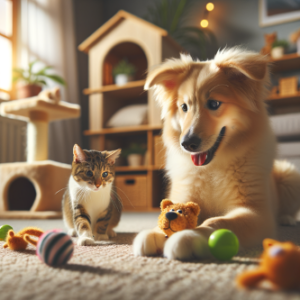
Individual Attention: The Heart of Multi-Pet Households
In a lively household filled with various pets, it’s easy to fall into the rhythm of group dynamics. Yet, amidst the playful chaos, it’s crucial not to overlook the importance of giving individual attention to each pet. Just as people thrive on personal connections, pets require one-on-one time to foster their well-being, build trust, and strengthen your bond. Let’s explore why this individual attention is vital and how to effectively integrate it into your daily routine.
The Benefits of Individual Attention
Providing individual attention to each pet is an essential aspect of maintaining their emotional health and overall household morale. Here are several benefits you may experience:
- Strengthened Bonds: Spending dedicated time with your pets helps to forge stronger relationships. It fosters trust and affection, ensuring your pets feel secure and loved.
- Behavioral Improvements: Individual attention can lead to reduced behavioral issues. When pets know they have your undivided attention, they are less likely to act out for attention among their peers.
- Increased Confidence: Personalized time can build your pets’ self-esteem and confidence, particularly for shy or anxious animals. Knowing they are special in their own right can alleviate fear and promote a happier disposition.
- Enhanced Communication: By focusing on each pet’s individual needs and behaviors, you’ll become better at reading their signals and adjusting your approach accordingly. This understanding leads to smoother interactions in a multi-pet environment.
- Overall Household Morale: A happy pet contributes to a happy household. Individual attention not only benefits the specific pet receiving it but also creates a more balanced and pleasant atmosphere for everyone involved.
Creating a Schedule for One-on-One Time
If providing individual attention is crucial, how can you effectively work it into your busy life? Here are some actionable tips:
- Set Specific Times: Dedicate specific time slots each day or week for individual interactions with each pet. Whether it’s a morning walk with your dog, a quiet cuddle session with the cat, or even enriching activities for your birds, scheduling it ensures that each pet gets their fair share of quality time.
- Incorporate Routine Activities: Try combining individual time with regular activities. For instance, feed each pet separately to bond during mealtimes, or engage in training sessions tailored for your dog’s unique temperament, which can also serve as a one-on-one moment.
- Rotate Focus: If you have multiple pets, rotate your focus based on their needs. For example, one day might focus on interactive play with the dogs, while the next is reserved for grooming and bonding with the cats. This helps prevent feelings of jealousy or neglect.
- Mindful Attention: When you are spending time with your pet, ensure it is genuine quality time. Put down your phone, turn off the TV, and engage fully—be present in the moment. This helps to deepen your bond and is especially important for pets who may need reassurance.
Real-World Examples of Individual Attention in Action
Let’s dive into a few scenarios where individual attention can turn a multi-pet household around:
- Case of the Shy Cat: Many households struggle with a timid pet who feels overshadowed by more outgoing roommates. By committing to regular one-on-one cuddle sessions, you can provide that shy cat with the affection and security it craves, enabling it to come out of its shell.
- Energetic Dog Needs Focus: An energetic dog may act out if it doesn’t receive enough physical and mental stimulation. Scheduling daily one-on-one playtime can channel that energy effectively, reducing anxiety and destructive behaviors while strengthening your bond.
- The Competitive Dynamics: In a multi-pet environment, one pet may dominate the attention. By actively making time for each pet, you not only alleviate envy but also reinforce the idea that you have enough love to go around. This can lead to more harmonious interactions during group play or mealtimes.
Monitoring and Adapting
As you incorporate individual attention into your routine, it is essential to monitor your pets’ reactions and adapt accordingly. Here are some strategies to keep in mind:
- Observe Body Language: Pay close attention to how your pets respond to their individual sessions. Are they relaxed, engaged, and eager for play, or do they appear stressed and overwhelmed?
- Be Flexible: Every pet is unique and may have varying needs at different times. Be prepared to adjust your schedule based on health, mood, and energy levels.
- Encourage Group Harmony: While focusing on individual pets, continue promoting positive interactions among them. Host group play sessions and provide opportunities for cooperative activities, ensuring everyone remains included.
Conclusion: Individual Attention Makes a Difference
In the journey of nurturing a multi-pet household, individual attention emerges as a cornerstone for ensuring each pet feels valued and secure. By scheduling time for one-on-one interactions, broadening your understanding of each pet’s unique needs, and monitoring behavioral changes, you create a supportive atmosphere where every pet can thrive.

Conflict Resolution Techniques: Dispersing Fights and Arguments Between Pets
Even in the most harmonious multi-pet households, conflicts can arise. Whether it’s a disagreement over a toy, a perceived invasion of personal space, or differing energy levels, fights and arguments can create a stressful atmosphere for both pets and their owners. Understanding conflict resolution techniques is vital to help maintain peace within a multi-pet setting. This section will provide immediate and long-term strategies for addressing these conflicts effectively.
Immediate Strategies for Conflict Resolution
When a conflict arises, quick and effective action is necessary to prevent escalation. Here are some immediate strategies that pet owners can implement to diffuse potential fights:
- Distraction Techniques:
- Redirect the pets’ focus by using a favorite toy or treat. Tossing a squeaky toy or offering a chew treat can help divert attention away from the source of conflict and encourage positive engagement.
- Use noise makers, such as a clap or a loud “uh-oh,” to interrupt fighting behavior and capture their attention.
- Calm Interventions:
- Approach the situation with calmness. Pets can sense tension, so maintaining a relaxed demeanor can help de-escalate the situation.
- Use a firm but gentle voice to command attention, reinforcing that the behavior is unacceptable without instilling further anxiety.
- Physical Separation:
- If required, separate the pets by using barriers or leashes to keep them apart temporarily. This helps to prevent further conflict while allowing them to cool off.
- Create a safe, neutral zone for each pet to retreat to, where they feel secure and can calm down.
- Time-Outs:
- Use the concept of a time-out by isolating the aggressor in a calm, quiet space for a few minutes. This allows them time to settle down and reflects that aggressive behavior is not acceptable.
Long-Term Strategies for Conflict Prevention
While immediate action is crucial during a conflict, long-term strategies can help reduce the likelihood of disputes arising in the first place. Here are several techniques that focus on establishing a peaceful coexistence:
- Consistent Training:
- Engaging your pets in obedience training can significantly improve their behavior and response to commands. Teaching commands such as “leave it,” “come,” and “sit” can help you take control of a situation calmly.
- Consider attending group training classes, which not only enhance skills but also help pets learn acceptable social behaviors around other animals.
- Establishing Routines:
- Consistent daily routines for feeding, walking, and playtime help create stability, reducing anxiety and competitive behaviors. Pets thrive on predictability, and establishing a routine can diminish territorial disputes.
- Make sure both pets have equal access to attention, exercise, and feeding times, ensuring that neither feels neglected or left out.
- Positive Reinforcement:
- Reinforce positive behaviors with treats and praise. When pets interact peacefully, offer treats or affection to encourage this behavior in the future.
- Implement reward-based training techniques, which can help pets associate positive actions with receiving rewards, promoting preferable social behaviors.
- Enrichment Activities:
- Regularly engage pets in activities that stimulate their minds and bodies. Providing puzzle toys, interactive play, and training sessions can keep them occupied and content, reducing the likelihood of conflicts due to boredom or excess energy.
- Schedule play dates or socialization opportunities with other pets, which can help socialize them with various animals and improve their overall interaction skills in a multi-pet environment.
- Regular Vet Check-Ups:
- Ensure that all pets receive regular veterinary care to rule out any health issues that may be affecting their behavior. Unexplained aggression or irritability can often stem from pain or discomfort.
- Pay attention to your pet’s health, including changes in their demeanor that may indicate stress or underlying conditions, ensuring any issues are addressed promptly.
Conclusion: Promote Peaceful Interactions
In navigating the complexities of multi-pet households, implementing effective conflict resolution techniques can greatly enhance the quality of life for both pets and humans. By combining immediate action with long-term strategies, owners can foster an environment where conflicts are minimized and harmonious interactions are prioritized.

When to Involve a Professional Trainer or Behaviorist
Despite your best efforts, sometimes the complexities of a multi-pet household can lead to challenges that are difficult to manage on your own. This is where involving a professional trainer or a behaviorist becomes crucial. They possess the expertise needed to address specific behavioral issues resulting from the interactions of your pets. Let’s explore the signs that indicate it’s time to seek professional help and how to select the right expert for your needs.
Signs You May Need a Professional
Recognizing when to call in a professional can save you time, stress, and heartache. Here are some key indicators that you may benefit from enlisting a trainer or behaviorist:
- Persistent Conflict: If you’re observing ongoing aggressive behavior between your pets, such as growling, biting, or severe hissing, it may be time to seek help. A professional can assess the situation, provide a behavior modification plan, and mediate the interactions.
- Fear-based Behavior: If one pet frequently exhibits signs of fear or anxiety around others, it’s crucial to address this quickly. A professional can help explore the reasons behind the fear and provide strategies to build the frightened pet’s confidence.
- Inconsistent Behavior: If your pets show erratic behavior—like sudden aggression or extreme shyness—this can indicate deeper behavioral issues. A trainer or behaviorist can help identify triggers and teach you how to manage these behaviors effectively.
- Limited Progress: If you’ve been trying to implement training techniques with little to no improvement, a fresh perspective from a professional can be beneficial. They can adjust your approach with tailored advice that suits your specific multi-pet dynamics.
- Inter-Species Issues: When dealing with different species, such as dogs and cats, conflicts can arise that require specialized knowledge. A professional with experience in multi-species behavior can address these concerns more effectively.
Choosing the Right Expert
Once you’ve determined that professional help is needed, finding the right trainer or behaviorist is essential for your pets’ well-being. Here are some criteria to consider during your selection process:
- Qualifications and Experience: Look for trainers or behaviorists who have relevant certifications from recognized organizations, such as the Association of Professional Dog Trainers (APDT) or the Certification Council for Professional Dog Trainers (CCPDT). Experience with multi-pet households specifically is a significant advantage.
- Approach to Training: Different trainers have varied training methodologies—some may focus on positive reinforcement while others might use aversive techniques. Opt for a professional who aligns with your own philosophy on animal welfare and employs humane techniques that foster trust and respect.
- References and Reviews: Don’t hesitate to ask for references or read online reviews. Hearing from other pet owners about their experiences can provide valuable insight into what to expect from a trainer.
- Initial Consultation: Take advantage of initial consultations, as many professionals offer them. This meeting allows you to assess their approach, communication skills, and compatibility with you and your pets.
- Specialization in Multi-Pet Dynamics: Some professionals specialize in multi-pet behavior issues. If you have a particular concern related to inter-species interactions or group behavior, seek out these experts for the best possible guidance.
Working with a Trainer: What to Expect
Engaging a professional trainer or behaviorist often involves a series of sessions tailored to your pets’ specific needs. Here’s what you can generally expect when working with an expert:
- Behavior Observation: The professional will first observe your pets in their environment to identify behaviors, triggers, and interactions that need addressing.
- Customized Plan: Based on their observations, the trainer will develop a customized behavior modification plan focusing on resolving conflicts, improving interactions, and enhancing social dynamics.
- Owner Guidance: Trainers will not only work with your pets, but they will also guide you through implementing techniques consistently in your home, ensuring that you reinforce positive behaviors.
- Progress Evaluations: As behavior modification takes time, regular evaluations will help track the progress of your pets. The trainer will adjust techniques as necessary based on how each pet responds.
- Education and Empowerment: An effective trainer will also educate you on understanding pet behavior, which can empower you moving forward in managing your multi-pet household.
Conclusion: Seek Help for a Harmonious Home
Recognizing when to involve a professional trainer or behaviorist is critical to maintaining harmony in a multi-pet household. By being proactive and choosing the right expert, you can help alleviate behavioral issues, enhance relationships among your pets, and create a peaceful environment for everyone in your home.
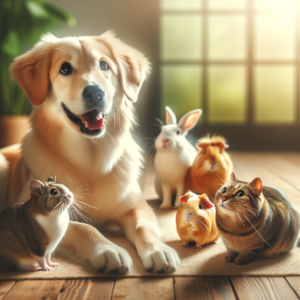
Monitoring Behavior Over Time: The Importance of Keeping a Behavioral Journal
When welcoming multiple pets into your home, maintenance of harmony extends beyond understanding their unique personalities and inter-species dynamics. Consistently monitoring your pets’ behaviors over time is equally vital as it allows you to spot any changes or issues. A behavioral journal or log can serve as an invaluable tool for pet owners to document interactions, identify patterns, and enhance the quality of life for both pets and their owners. Let’s explore how to effectively implement this practice.
The Value of Tracking Behaviors
Consistent observation and documentation of your pets’ behaviors can lead to several benefits:
- Early Detection of Issues: Behavior changes can be early indicators of stress, health problems, or discomfort. By tracking these changes, you can address issues before they escalate.
- Improving Training and Development: Keeping notes on responses to commands or social interactions helps refine training approaches. If a certain command always results in anxiety, you can adjust your methods accordingly.
- Enhancing the Environment: Understanding how and when pets engage with each other allows for better management of their spaces and resources, creating a more conducive living environment.
Tips for Keeping a Behavioral Journal
A behavioral journal doesn’t need to be complex; it can be as simple as a notebook or an app on your phone. Here are some practical tips to help you maintain an effective behavioral log:
- Choose a Format That Works for You:
- Digital Options: Consider using apps designed for pet care, which may include features like reminders or alerts for various behaviors.
- Traditional Notebook: If you prefer pen and paper, dedicate a notebook specifically for this purpose.
- Record Consistently:
- Setting a routine can help. Consider logging behaviors daily or weekly, making it easier to notice patterns over time.
- Create specific sections for each pet to ensure that data is organized and clear.
- Include Key Details:
- Date and Time: Always note when the behavior occurred. This helps to identify trends in specific environments or situations.
- Context: Document details surrounding the behavior. For example, who was present, the location, and what activities were happening.
- Specific Behaviors: Be specific about what you observe, whether it’s a friendly play session, signs of aggression, or changes in eating habits.
- Use Descriptive Language:
- Instead of writing “my cat is acting weird,” elaborate with specific observations. Describe the physical actions (pacing, hiding) and contextual triggers (loud noises, new visitors).
- Review Regularly:
- Set aside time, perhaps monthly, to review your entries. Look for recurring themes or shifts in behavior. This can be particularly helpful in spotting patterns during introductions or changes in the household.
Analyzing and Responding to the Data
Once you’ve established a routine of logging behaviors, the next step is analyzing this information to develop actionable insights.
- Look for Patterns: If you consistently observe a particular pet feeling anxious around new visitors or after a change in routine, you can develop strategies to ease that anxiety, such as gradual introductions or creating a safe space.
- Modify Training Techniques: If training sessions yield inconsistent results, your journal will help identify which approaches are most effective for each pet, allowing for adjustments that cater to their individual personalities.
- Communicate with Professionals: Keep in mind that this journal can be a valuable resource if you decide to consult a veterinarian or animal behaviorist. It provides concrete examples of behavior changes and interactions.
Real-World Examples
Many pet owners have found success with behavioral journaling. For instance, Alex, a dog owner, noticed that her two dogs would frequently engage in aggressive behaviors during dinner time. By documenting their interactions in her behavioral journal, she realized that this pattern often occurred after a change in feeding schedule. Adjusting their meal times back to a previously established routine significantly reduced confrontations.
Similarly, Lisa, a cat owner, recorded her cat’s sudden increase in hiding behaviors and vocalizations after a move. By tracking the timeline, she was able to correlate the behavior changes with the stress of relocating, allowing her to enhance her cat’s comfort level by providing a designated cozy space within the new environment.
Conclusion: Observe and Adjust for a Harmonious Multi-Pet Household
Monitoring your pets’ behaviors over time is essential for fostering a peaceful living environment in a multi-pet household. By keeping a detailed behavioral journal, you can effectively identify problem areas and enhance your ability to manage interactions positively. Not only does this practice benefit pet owners, but it also contributes to the overall well-being of all your furry companions.

Preparing for Changes: Easing Transitions in Your Multi-Pet Household
Even in the most harmonious multi-pet households, changes can stir up anxiety and stress among our furry friends. Whether it’s moving to a new home, adding a new family member through adoption, or even just altering your routine, it’s vital to prepare your pets for these transitions. Being proactive can prevent behavioral issues and ensure that your multi-pet environment remains peaceful and loving. Let’s explore effective strategies for handling changes in your pet family.
The Challenges of Change
Change, while exciting for humans, can be a source of anxiety for pets. Animals thrive on routine, and interruptions can lead to stress, aggression, or anxiety. For instance, a dog may start barking excessively or a cat may withdraw when faced with an unfamiliar setting. Recognizing these potential challenges is the first step in mitigating them.
Moving to a New Home
Transitioning to a new environment can be particularly daunting for pets, as they have to adapt to new smells, sounds, and spaces. To facilitate a smooth move, consider these action steps:
- Create a Safe Space: When you arrive in your new home, establish a designated area for your pets. This should be a quiet room with their favorite blankets, toys, and feeding station. Allow them to acclimate to this space before letting them explore the rest of the house.
- Stick to Routines: Try to maintain your pet’s regular feeding and walking schedule as much as possible. Familiar routines can provide comfort and stability in an otherwise confusing time.
- Familiar Scents: Bring items from your old home, like bedding or toys, to help your pets feel more secure in their new environment. Familiar smells can ease their transition.
- Gradual Exploration: Allow your pets to explore the new home at their own pace. Supervise during the exploration to make sure they feel supervised and safe.
- Integration with New Surfaces: Pets may find various flooring types, such as tile or hardwood, intimidating. Allow them to adjust to these surfaces gradually, encouraging gentle interaction.
Adopting New Pets
Welcoming a new pet into your home can be an exciting time, but it requires careful planning to ensure all pets feel comfortable. Here are essential strategies to support a smooth introduction:
- Separate Spaces Initially: Just like with new furry friends, allow time for pets to become accustomed to one another’s scent before meeting face-to-face. Create spaces with food, water, and toys to help everyone feel secure.
- Individual Attention: Spend one-on-one time with each pet before and after introducing the new arrival. This helps to alleviate feelings of jealousy or neglect among your existing pets.
- Supervised Interactions: When the time comes for the initial interactions, watch for signs of stress or aggression in both the new pet and the existing ones. Use a leash if necessary to ensure everyone’s safety.
- Positive Reinforcement: Reward all pets for calm behavior during introductions. This might be through treats, praise, or playtime. Associations of positive experiences can help ease any initial anxiety.
- Tailored Integration: Every pet has a unique personality. Consider gradual introductions based on their temperaments. For example, a more dominant dog may need a structured introduction with minimal stimuli, while a social cat may enjoy more direct engagement.
Establishing New Routines
Changes often necessitate adjustments to daily routines. This can be disorienting for pets and may lead to behavioral issues if not managed properly. Here’s how to establish new routines:
- Maintain Consistency in Feeding: If changes in feeding times or locations occur, try to maintain consistency for your pets. Gradual shifts in feeding schedules are often better received than sudden alterations.
- Gradual Introductions to New Activities: Introduce new walks, parks, or playtimes slowly to help pets adjust. Give your pets time to be comfortable with new experiences.
- Monitor Behavioral Responses: Watch for behavioral changes, such as increased aggression, withdrawal, or excessive vocalization. These signs can indicate that your pet is struggling to adapt and may require your attention.
- Structured Interaction Times: Set aside specific times for play, training, and social interaction to create predictability, which can help all pets feel more secure in their daily lives.
- Training Sessions: Incorporate basic obedience training or new tricks. Training provides mental stimulation and strengthens the bond between you and your pets during periods of transition.
Maintaining Social Harmony
Change doesn’t happen in isolation, and existing pets may feel threatened or insecure when new elements come into play. Here’s how to maintain social harmony during transitions:
- Observe Interactions Closely: Pay attention to body language, vocalizations, and behavioral changes during transitions. Early identification of stress indicators can help prevent escalation.
- Fair Resource Distribution: Ensure that resources like toys, food bowls, and resting areas are equally accessible to all pets. Competitive situations arise when pets feel they must guard resources.
- Regular Socialization: Keep pets socialized during changes by engaging in group activities or playtimes. Scheduled interactions can help solidify their social structure.
- Communicate Calmly: Your demeanor significantly influences how pets respond to change. Stay calm and positive to help everyone feel secure.
- Provide Extra Attention: After changes, your pets may need additional love and reassurance. Spend extra quality time together to help them adjust emotionally.
Conclusion: Adapt and Thrive in a Multi-Pet World
Successfully transitioning your multi-pet household through periods of change requires preparation, sensitivity, and ongoing efforts to maintain harmony. By setting the stage for your existing pets and new additions, you can ensure that routines are stable and behaviors remain manageable. Whether moving or adopting, knowing your pets’ needs, adapting their environments, and providing consistent support can help them thrive amid change.

Conclusion and Future Considerations
Navigating the complexities of a multi-pet household is no small feat, but with the right strategies, it can certainly be a rewarding endeavor. As we’ve explored, understanding the unique personalities of each pet and establishing a positive social structure significantly contribute to harmony within your home.
Key strategies discussed include:
- Gradual Introductions: This method allows pets to acclimate at their own pace, fostering a sense of comfort and security. Remember the importance of separate spaces, scent swapping, and controlled meetings to ease the integration process.
- Socialization Experiences: Regular outings and interactions can help pets learn appropriate social cues and behaviors. Engaging in training sessions and playdates not only builds confidence but also enhances communication skills among different species.
- Space and Resources: By providing distinct feeding stations, play zones, and private retreats, you can reduce competition and promote peaceful cohabitation. This step is crucial in preventing resource guarding and ensuring every pet feels secure and valued.
- Behavior Analysis: Effective monitoring of body language, vocalizations, and posture can reveal much about your pets’ comfort levels. Being attuned to these signals enables you to intervene when necessary, maintaining a peaceful environment.
As housing dynamics inevitably change—whether due to a new pet joining the family or an existing pet transitioning through different life stages—it’s vital to revisit these strategies periodically. Re-evaluating your household’s social structure and interactions will help you adapt to new developments, ensuring the well-being of all pets involved.
Moreover, continuing education and resource exploration can further enhance your ability to manage multi-pet dynamics effectively. Books, online courses, and seminars on pet behavior can offer additional insights that may be beneficial as your household evolves.
In conclusion, creating an ideal multi-pet household is an ongoing journey that requires effort, patience, and a willingness to learn and adapt. By implementing the strategies discussed and staying engaged with your pets’ needs, you can cultivate a harmonious living environment.
news via inbox
Nulla turp dis cursus. Integer liberos euismod pretium faucibua

